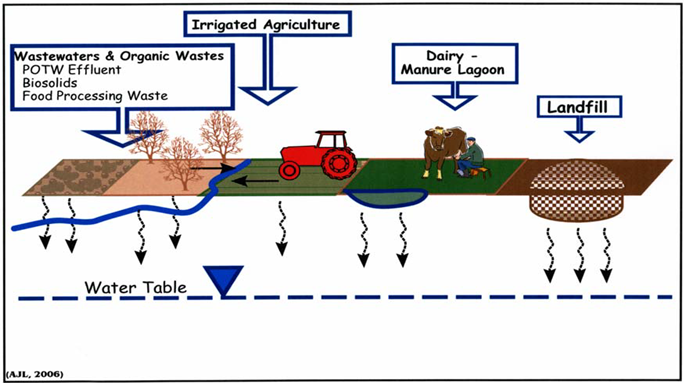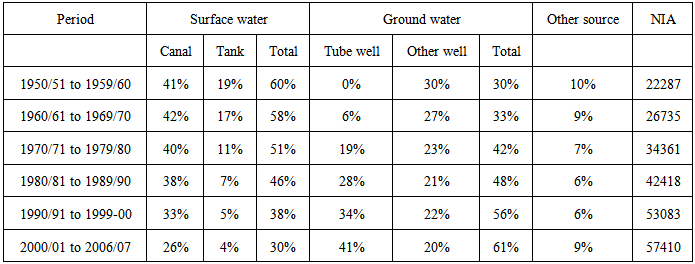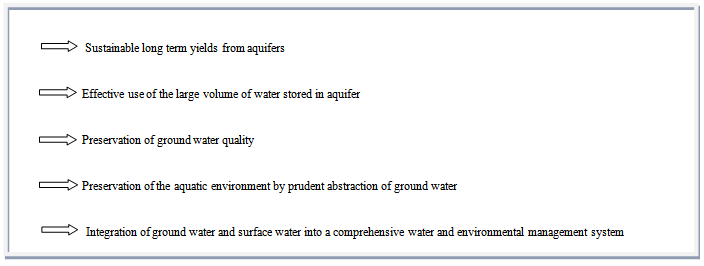-
Paper Information
- Next Paper
- Previous Paper
- Paper Submission
-
Journal Information
- About This Journal
- Editorial Board
- Current Issue
- Archive
- Author Guidelines
- Contact Us
International Journal of Ecosystem
p-ISSN: 2165-8889 e-ISSN: 2165-8919
2015; 5(3A): 43-46
doi:10.5923/c.ije.201501.06
Groundwater Sustainability - A Brief Review
Sucharita Mitra
Assistant Professor (Sr. Scale) in History, Jatindra Rajendra Mahavidyalaya, Amtala, Murshidabad
Correspondence to: Sucharita Mitra, Assistant Professor (Sr. Scale) in History, Jatindra Rajendra Mahavidyalaya, Amtala, Murshidabad.
| Email: |  |
Copyright © 2015 Scientific & Academic Publishing. All Rights Reserved.
Groundwater is the water found under ground in the cracks and spaces in soil, sand and rock. It is stored in and moves slowly through geologic formations of soils, sand and rocks called aquifers. It is one of the Nation’s most important natural resources. It plays a major role in ensuring livelihood security across the world, especially in economies that depend on agriculture. Ground water contains mineral ions which slowly dissolve from soil particles, sediments, and rocks named as dissolved solids. Continuous discharge of industrial effluents, domestic sewage use of fertilizers and pesticides, waste dump and over exploitation of the resource have badly impact on ground water sustainability. Though over utilization of ground water is the key factor for ground water depletion but there are other factors which have negative impact on ground water sustainability. The most important impact of groundwater depletion is loss of base flow; other impacts being severe crisis of safe drinking water and irrigated water. Lastly it is to be mentioned that protection of the water resource from depletion is not possible unless the users agree to cooperate and manage the resource themselves in a sustainable manner. Moreover the state also needs to play a key role of facilitating and fostering community action for sustainable management.
Keywords: Groundwater, Aquifers, Depletion, Sustainability
Cite this paper: Sucharita Mitra, Groundwater Sustainability - A Brief Review, International Journal of Ecosystem, Vol. 5 No. 3A, 2015, pp. 43-46. doi: 10.5923/c.ije.201501.06.
Article Outline
1. Introduction
- Groundwater is one of the extremely valuable renewable resources. Now a day’s pollution of groundwater resources is a matter of serious concern. Groundwater quality comprises the physical, chemical, and biological qualities of ground water.viz Temperature, turbidity, color, taste, and odor are represent the physical quality whereas pH, E.C, N, P, K, Organic Carbon etc. represent the chemical quality and total microbial count etc. stand for biological quality of ground water. Naturally, ground water contains mineral ions which slowly dissolve from soil particles, sediments, and rocks named as dissolved solids.Microbial components are also available in ground water. There are different forms where ground water is stored and human can withdrawal from there namely aquifer, wells etc. Aquifers are divided into two types (confined and unconfined) depending on the position relative to surface and other permeable and impermeable layers. Man made activities play a key role for depletion of natural composition of ground water through the disposal or dissemination of toxic chemicals and microbial matter at the land surface and into soils, or through waste water. In India, most of the population is dependent on groundwater as the only source of much clean drinking water supply than surface water. Continuous discharge of industrial effluents, domestic sewage use of fertilizers and pesticides, waste dump and over exploitation of the resource have badly impact on ground water sustainability (Harter T.). So, sustainable ground water management is a burning challenge for the 21st century because it ensured livelihood security across the world. Agriculture dependent countries (viz. India) are mostly relied on ground water.
|
|
2. Global Fresh Water Demand and Ground Water Depletion
- Fresh water demand rise day by day especially for irrigation purpose. The percentage of total irrigation water withdrawal from ground water increased 23 percent in 1950 to 42 percent in 2000 (Hutson, 2004). Water shortage increased dramatically and it is projected that around 3 billion will be water stressed by 2025 (Engelman and LeRoy, 1993).From the above table we can say that increasing demand of water and decreasing availability of water create a significant pressure on groundwater and this ultimately deplete the ground water quality. At present approximately 61% of total irrigation water is come from groundwater (Kulkarni et al).
|
|
 From the above table we can say that expansion of agricultural field and decreasing pattern of usage of surface water accelerate the over exploitation of ground water. There are a various example of over usage of groundwater but a classic case is the water level in Borrego valley, Southern California have declined 2 feet per year over the past 20 years (Victor M. ponce, 2006). Though over utilization of ground water is the key factor for ground water depletion but there are also other important factors those have negative impact on ground water sustainability. Contamination or Presumption contamination also has adverse impact on ground water. Agricultural chemicals like N, P, K, pesticides etc. percolate through soil and contaminate the ground water. A sampling program in Wisconsin found that pesticides are present in 38% of their samples from wells in the state (Krohelski, 2004).Naturally occurring constituents like arsenic fluoride, chloride etc. contaminate the ground water and made the water unsafe. Murshidabad district of West Bengal is an arsenic porn area. Increasing efforts to protect and enhance In-stream flow and aquatic ecosystems also limit the amount of ground water available for extraction.
From the above table we can say that expansion of agricultural field and decreasing pattern of usage of surface water accelerate the over exploitation of ground water. There are a various example of over usage of groundwater but a classic case is the water level in Borrego valley, Southern California have declined 2 feet per year over the past 20 years (Victor M. ponce, 2006). Though over utilization of ground water is the key factor for ground water depletion but there are also other important factors those have negative impact on ground water sustainability. Contamination or Presumption contamination also has adverse impact on ground water. Agricultural chemicals like N, P, K, pesticides etc. percolate through soil and contaminate the ground water. A sampling program in Wisconsin found that pesticides are present in 38% of their samples from wells in the state (Krohelski, 2004).Naturally occurring constituents like arsenic fluoride, chloride etc. contaminate the ground water and made the water unsafe. Murshidabad district of West Bengal is an arsenic porn area. Increasing efforts to protect and enhance In-stream flow and aquatic ecosystems also limit the amount of ground water available for extraction.3. Impact of Ground Water Depletion
- The most important impact of groundwater depletion is loss of base flow. If the base flow is reduced then there are different crucial additional impacts take place. These are:• Increased magnitude and frequency of flood• Loss of wetland and riparian vegetation• Changes in channel morphology• Accelerate erosion• Increased frequency of drought• Loss of biodiversityOther impacts of ground water depletion are severe crisis of safe drinking water and irrigated water.
4. Ground Water Management
- Groundwater, as a valuable resource we should meet its sustainability for our basic needs. Firstly we should not exploit in an unsustainable manner. Ground water use policy should be sustainable and depend on basin´s recharge capacity. We should follow the groundwater basin´s mass balance equation P-E-T-Q-G-D = 0Where P = precipitation, E = evaporation, T = evapotranspiration, Q = surface runoff, G = groundwater runoff, D = deep percolation (Ponce. V. 2006).In rural areas where ground water is the main source for drinking water, implementation of wellhead protection is necessity and secondly must control the waste water to percolating through soil and disposing of waste water to neighboring septic systems. Tapping primary deep percolation and secondarily shallow percolation are important measures for maintaining groundwater sustainability. Baseline and time dependent hydrological studies are necessary to monitor the ground water.
5. The Priorities for Ground Water Management
- There are also some strategies to promote sustainable ground water supply. Conjunctive use of surface water and ground water, desalination, recycling and wastewater reuse, water harvesting, increase recharge to the ground water system are also a effective measure to promote sustainable ground water supply. Lastly awareness should be raise towards ground water sustainability.
|
 Abstract
Abstract Reference
Reference Full-Text PDF
Full-Text PDF Full-text HTML
Full-text HTML



